管理学原理11版第一章的配套英文版ppt
管理学(英文版全套课件)
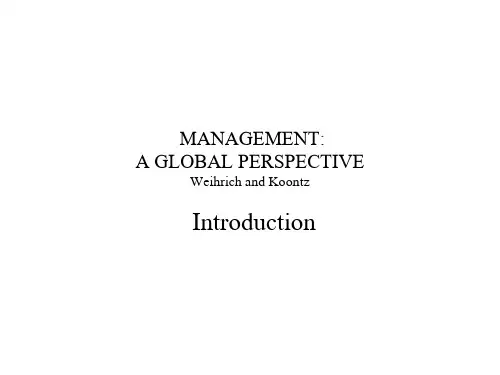
Arguments Against Social Involvement
• • • • • • • Violation of profit maximization Dilution of purpose Costs Too much power Lack of skills Lack of accountability Lack of universal support
• France
– Le Plan and the Cadre
• Germany
– Authority and Codetermination
• Korea
– Chaebol and Inhwa
Japanese Management
• Lifetime Employment • Seniority System • Decision Making in Japan
Chapter 2. Management and Society: The External Environment, Social Responsibility, and Ethics
The Organization and Its External Environment
Arguments for Social Involvement
Definition of Whistle-Blowing
2011_罗宾斯_管理学_11版_英文PPT_12
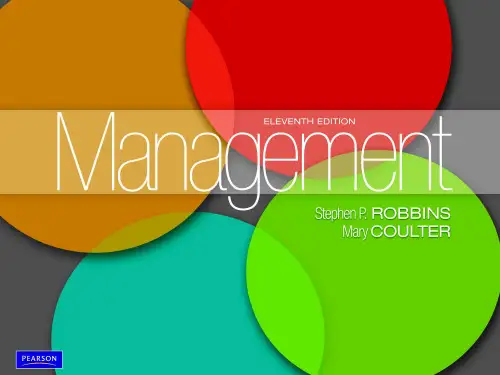
Supply of Employees
Demand for Employees
Factors Affecting Staffing
Strategic Goals Forecast demand for products and services Availability of knowledge, skills, and abilities
•
List eight activities necessary for staffing the organization and sustaining high employee performance.
Discuss the environmental factors that most directly affect the HRM process.
12
Chapter
Why Human Resources Is Important: The HRM Process
•
Explain how an organization’s human resources can be a significant source of competitive advantage.
•
•
Explain why orientation is so important.
Describe the different types of training and how that training can be provided.
Employee Performance Management; Compensation/Benefits; Career Development
Job
管理学原理 英文版 第一章
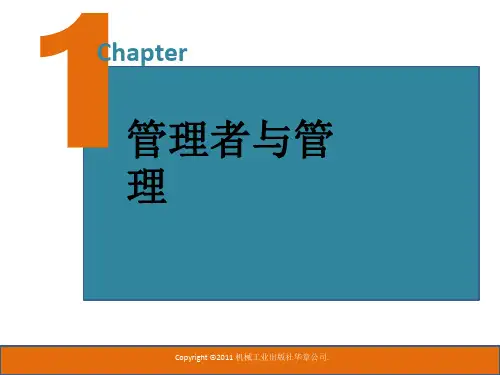
1-9
什么是管理?
• 管理
– 通过与其他人共同努力,既有效率又有效果地 把事情做好的过程
• 效果
– 是指做正确的事,通过做这些工作任务从而帮 助组织达到既定目标
• 效率
– 关注的是方法,即有效地使用人员、资金和设 备
Copyright © 2011 Pearson Education, Inc. Publishing as Prentice Hall. 1-10
Chapter
管理者与管 理
Copyright © 2011 机械工业出版社华章公司.
学习目标:
• • • • • 识别谁是管理者以及他们在哪里工作 定义什么是管理 描述管理者的工作 解释为什么学习管理非常重要 描述重新塑造和重新定义管理的要素
Copyright © 2011 Pearson Education, Inc. Publishing as Prentice Hall.
1-31
为什么对管理者工作来说创新很重要?
• “再也没有比不创新 更具风险了”
• 创新不只是对高技术 公司重要,而是所有 类型的组织所必须的。
Copyright © 2011 Pearson Education, Inc. Publishing as Prentice Hall.
1-32
历史单元
1-8
管理者在组织中的称谓是什么?
• 高层管理者
– 负责制定与组织发展方向有关的决策 – 总裁、副总裁、首席执行官
• 中层管理者
– 管理另外一些管理者 – 例如,地区经理、部门经理
• 基层管理者
– 负责指导非管理类员工
– 例如,主管、团队领导
Copyright © 2011 Pearson Education, Inc. Publishing as Prentice Hall.
2011_罗宾斯_管理学_11版_英文PPT_04
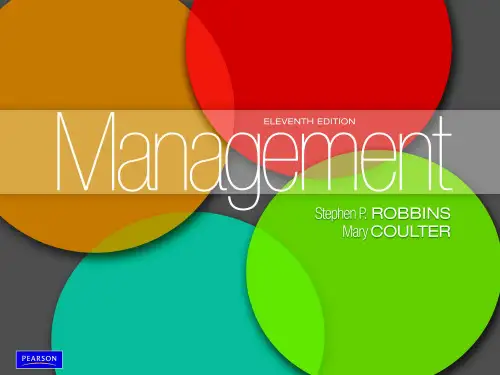
Stereotyping
- judging a person based on a prejudicial perception of a group to which that person belongs. Discrimination - when someone acts out their prejudicial attitudes toward people who are the targets of their prejudice. Glass Ceiling - the invisible barrier that separates women and minorities from top management positions.
Bias
- a tendency or preference toward a particular perspective or ideology. Prejudice - a preconceived belief, opinion, or judgment toward a person or a group of people.
Age -
Both Title VII of the Civil Rights Act of 1964 and the Age Discrimination in Employment Act of 1967 prohibit age discrimination. Gender - Women (49.8%) and men (50.2%) now each make up almost half of the workforce.
Employee
Resource Groups - groups made up of employees connected by some common dimension of diversity.
管理学原理 英文版c11
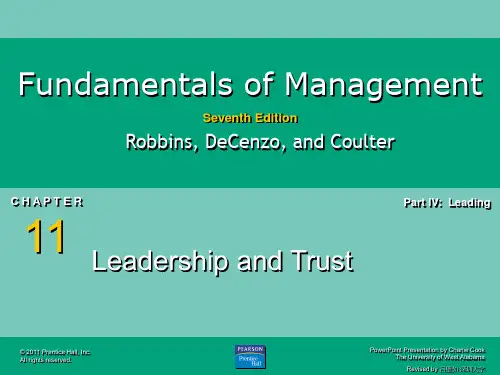
followers’ readiness
• Readiness
The extent to which people have the ability and
willingness to accomplish a specific task
impoverished management
task management middle-of-the-road management
country club
team management
© 2011 Prentice Hall, Inc. All rights reserved.
such as hiring, firing, discipline, promotions, and salary increases
© 2011 Prentice Hall, Inc. All rights reserved.
Copyright © 2011 Pearson Education
11–15
freedom to make decisions and to complete their work however they see fit
© 2011 Prentice Hall, Inc. All rights reserved.
Copyright © 2011 Pearson Education
© 2011 Prentice Hall, Inc. All rights reserved.
Copyright © 2011 Pearson Education
11–7
管理学原理(PPT)

高
1.9
9.9
对 人 的 关 心
5.5
低
1.1
9.1
低
对生产的关心
高
领导权变理论
菲德勒将权变理论具体化为三个方面: 菲德勒将权变理论具体化为三个方面:
人际关系 工作结构 职位权力
领导高目 标
工作 领导低目标 人际关 系 人际关系 工作
环境较好
环境较差
LPC型领 低LPC型领 LPC型领 高LPC型领 导 导 领导目标与环境关系图: 领导目标与环境关系图:
决策的方法 头脑风暴法 名义小组技术 德尔菲技术
第六讲 计划
计划:是指为实现组织既定的目标, 计划:是指为实现组织既定的目标,对未来的行动规划和安排的 活动 计划的内容: 计划的内容:5W1H
计划的类型
类 准 分 标 间 短 时 长 能 间 职 空 合 程 综 性 度 (涉 时 长 和 及 范 涉 间 短 涉 的 围 及 广 ) 狭 确 明 性 序 程 程 化 度 型 类 长 计 期 划 短 计 期 划 业 计 务 划 财 计 务 划 人 计 事 划 略 计 战 性 划 战 性 划 术 计 体 计 具 性 划 指 性 划 导 计 程 性 划 序 计 非 序 计 程 性 划
管理学原理
第一章 管理与管理学
管理是管理者为了有效的实现组织目标(以及个人发展和社会 责任),运用管理职能进行协调的过程。 其本质是协调。
职能 计划、组织、领导、控制、 计划、组织、领导、控制、创新 管理者的角色 人际角色、信息角色、决策角色 人际角色、信息角色、 技能 技术技能、人际技能、 技术技能、人际技能、概念技能 不同层次的管理者对各技能的要求不一样
有效沟通的障碍 个人因素:主要包括选择性接受和沟通技巧的差异; 个人因素:主要包括选择性接受和沟通技巧的差异; 人际因素:主要包括沟通双方的相互信任、 人际因素:主要包括沟通双方的相互信任、信息来源的可靠程 度、发送者与接受者之间的相似程度; 发送者与接受者之间的相似程度; 结构因素:主要包括地位差别、信息传递链、 结构因素:主要包括地位差别、信息传递链、团体规模和空间 约束。 约束。 技术因素:主要包括语言、非语言按时、 技术因素:主要包括语言、非语言按时、媒介的有效性和信息 过量。 过量。
英文版管理学原理,Principles od management 第一章
incentives that align employees’and organization’s interests
5
9/27/2007
1 - 11
Benefits & Incentives
1-8
Who Makes the Strategic Decisions?
By Senior Group including CEO With Formal Strategic Planning Process By Business Unit Leaders By CEO or Equivalent By Others
Source: Best of 2005, Business Week, December 19, 2005
7
Question
•Are the functions of management only for managers in organizations or can they apply to you as a student as well? Explain.
1. Describe the basic functions of management 2. Identify where in an organization managers are
located 3. Discuss the challenges people encounter as they
become first-line managers 4. Describe the roles managers adopt to perform the
管理学罗宾斯第11版01
©2012 Pearson Education, Inc. publishing as Prentice Hall
1-7
Exhibit 1-2: Characteristics of Organizations
Management, Eleventh Edition by Stephen P. Robbins & Mary Coulter
Decisional roles
Entrepreneur, disturbance handler, resource allocator, negotiator
Management, Eleventh Edition by Stephen P. Robbins & Mary Coulter
©2012 Pearson Education, Inc. publishing as Prentice Hall
Common Characteristics of Organizations
Have a distinct purpose (goal) Are composed of people Have a deliberate structure
Management, Eleventh Edition by Stephen P. Robbins & Mary Coulter
Management, Eleventh Edition by Stephen P. Robbins & Mary Coulter
©2012 Pearson Education, Inc. publishing as Prentice Hall
1-3
Who Are Managers?
Manager
管理学第十一版Chapter1
Chapter1Management and OrganizationsWho Are Managers?什么是管理者?Manager(管理者):Someone who coordinates and oversees the work of other people so that organizational goals can be accomplished.协调和监督其他人的工作,使组织的目标可以完成的人。
Classifying Managers管理者的分类1.First-line Managers(基层管理者)Are at the lowest level of management and manage the work of non-managerial employees.处于最低水平的管理,管理非管理人员的工作。
2.Middle Managers(中层管理者)Manage the work of first-line managers.管理基层管理者3.Top Managers(高层管理者)Are responsible for making organization-wide decisions and establishing plans and goals that affect the entire organization.负责组织范围内的决策,并制定影响整个组织的计划和目标Managerial Levels管理的层次What Is Management?什么是管理?Management: Coordinating and overseeing the work activities of others so that they are completed efficientlyand effectivelywith and through other people.定义:协调和监督其他人的工作活动,通过其他人的工作使工作活动能够被高效、有效地完成。
2011-罗宾斯-管理学-11版-英文PPT-09
Step 6: Evaluating results
Analyzing financial and physical assets is fairly easy, but assessing intangible assets (employee skills, culture, corporate reputation, etc.) isn’t as simple.
Functional strategy - the strategies used by an organization’s various functional departments to support the competitive strategy.
Threat of New Entrants
Core competencies - the organization’s major value-creating capabilities that determine its competitive weapons.
Step 4: Formulating strategies
Develop and evaluate strategic alternatives.
Strategic management - what managers do to develop the organization’s strategies.
- 1、下载文档前请自行甄别文档内容的完整性,平台不提供额外的编辑、内容补充、找答案等附加服务。
- 2、"仅部分预览"的文档,不可在线预览部分如存在完整性等问题,可反馈申请退款(可完整预览的文档不适用该条件!)。
- 3、如文档侵犯您的权益,请联系客服反馈,我们会尽快为您处理(人工客服工作时间:9:00-18:30)。
1-2
Why are Managers Important?
• Efficiency
– “Doing things right” – Getting the most output for the least inputs
• Effectiveness
– “Doing the right things” – Attaining organizational goals
– Figurehead, leader, liaison
• Informational roles
– Monitor, disseminator, spokesperson
• Decisional roles
– Entrepreneur, disturbance handler, resource allocator, negotiator
©2012 Pearson Education, Inc. publishing as Prentice Hall
1-8
What Do Managers Do?
• Management involves coordinating and overseeing the work activities of others so that their activities are completed efficiently and effectively.
Management, Eleventh Edition by Stephen P. Robbins & Mary Coulter
©2012 Pearson Education, Inc. publishing as Prenticr Functions of Management
Management, Eleventh Edition by Stephen P. Robbins & Mary Coulter
©2012 Pearson Education, Inc. publishing as Prentice Hall
1-5
Exhibit 1-1: Levels of Management
Management, Eleventh Edition by Stephen P. Robbins & Mary Coulter
©2012 Pearson Education, Inc. publishing as Prentice Hall
1-11
Management Functions
• Planning - Defining goals, establishing strategies to achieve goals, and developing plans to integrate and coordinate activities. • Organizing - Arranging and structuring work to accomplish organizational goals. • Leading - Working with and through people to accomplish goals. • Controlling - Monitoring, comparing, and correcting work.
Management, Eleventh Edition by Stephen P. Robbins & Mary Coulter
©2012 Pearson Education, Inc. publishing as Prentice Hall
1-10
Exhibit 1-3: Efficiency and Effectiveness in Management
– Someone who coordinates and oversees the work of other people so that organizational goals can be accomplished.
Management, Eleventh Edition by Stephen P. Robbins & Mary Coulter
Management, Eleventh Edition by Stephen P. Robbins & Mary Coulter
©2012 Pearson Education, Inc. publishing as Prentice Hall
1-1
• Explain why managers are important to organizations • Tell who managers are and where they work • Describe the functions, roles, and skills of managers • Describe the factors that are reshaping and redefining the manager’s job • Explain the value of studying management
Management, Eleventh Edition by Stephen P. Robbins & Mary Coulter
©2012 Pearson Education, Inc. publishing as Prentice Hall
1-13
Management Roles
• Roles are specific actions or behaviors expected of a manager. • Mintzberg identified 10 roles grouped around interpersonal relationships, the transfer of information, and decision making.
– Have a distinct purpose (goal) – Are composed of people – Have a deliberate structure
Management, Eleventh Edition by Stephen P. Robbins & Mary Coulter
Management, Eleventh Edition by Stephen P. Robbins & Mary Coulter
©2012 Pearson Education, Inc. publishing as Prentice Hall
1-9
Effectiveness and Efficiency
©2012 Pearson Education, Inc. publishing as Prentice Hall
1-7
Exhibit 1-2: Characteristics of Organizations
Management, Eleventh Edition by Stephen P. Robbins & Mary Coulter
Management, Eleventh Edition by Stephen P. Robbins & Mary Coulter
©2012 Pearson Education, Inc. publishing as Prentice Hall
1-15
Exhibit 1-5: Mintzberg’s Managerial Roles
Management, Eleventh Edition by Stephen P. Robbins & Mary Coulter
©2012 Pearson Education, Inc. publishing as Prentice Hall
1-6
Where Do Managers Work?
• Organization - A deliberate arrangement of people assembled to accomplish some specific purpose (that individuals independently could not accomplish alone). • Common Characteristics of Organizations
Management, Eleventh Edition by Stephen P. Robbins & Mary Coulter
©2012 Pearson Education, Inc. publishing as Prentice Hall
1-16
Skills Managers Need
• Technical skills
• Organizations need their managerial skills and abilities more than ever in these uncertain, complex, and chaotic times. • Managerial skills and abilities are critical in getting things done. • The quality of the employee/supervisor relationship is the most important variable in productivity and loyalty.
Management, Eleventh Edition by Stephen P. Robbins & Mary Coulter
